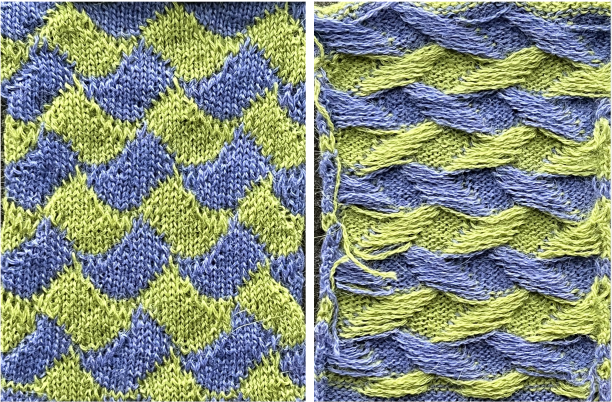“Automating ” normally labor-intensive hand techniques cannot truly duplicate them. Below is one effort to produce an “entrelac-like” fabric using the slip stitch setting. The biggest advantage of this is the knitting speed as opposed to creating the individual cells using holding and picking up stitches. Some drawbacks: slip stitch floats on the reverse make for a dense fabric, and may be an issue in a garment. There are elongated stitches along the edges of the shapes at the color changes, these cannot be avoided. I am not a fan of the Brother single bed color changer so I opted for changing the color by hand. “Air knitting” helps one sort out where to set up the pattern on the machine. The fabric is knit using the slip setting, so I chose placement on the KM where I had needles selected on each side of the knit on my first row.
The pattern is begun on row 8, card locked, COL.
The first-row preselection is to the right.
COR, card to advance normally, KC set to slip in both directions, change color after 8 rows of knitting, then every 14 rows.
As in any slip-stitch design, punched holes will knit stitches, unpunched holes will skip them, creating floats on the purl side between knit stitches.  The green dot on the right of the card indicates the starting row for the first repeat, row 8, subsequent lines are reminders to change color before knitting across that particular row, taking into account the fact that the card reader is reading below the line of sight on the machine’s exterior.
The green dot on the right of the card indicates the starting row for the first repeat, row 8, subsequent lines are reminders to change color before knitting across that particular row, taking into account the fact that the card reader is reading below the line of sight on the machine’s exterior.  Note that before the color change the yarn in use will create a float in the area that will be skipped by, and knit in the same area as the subsequent color will; at first, this may seem counter-intuitive, but it is correct, and the effect may be seen on both sides of the swatch.
Note that before the color change the yarn in use will create a float in the area that will be skipped by, and knit in the same area as the subsequent color will; at first, this may seem counter-intuitive, but it is correct, and the effect may be seen on both sides of the swatch.
If changing color by hand, remember to “close the gate” after each color change to avoid dropping the knitting off the machine if the yarn in use moves too far forward to be “caught and knit” by the appropriate needles.
With necessary adjustments in starting row and settings, technically this fabric may be knit on any KM brand.
The yarn in this test is the same alpaca/silk blend used in my shawls, at tension 6. If a color changer is used, the KC row must be from right to left with knitting rows moving left to right and back to the color changer.
2023
The same repeat may be used double-bed as well, using single or multiple colors, with the potential for variations in striping.
The minimum electronic size repeat is 12X28 pixels.
The red cells in the chart indicate the greatest number of rows, 12, that any one stitch will be held until a black pixel knits that same now very elongated stitch on the next pass.  The main bed is set to slip in both directions, and the ribber is set to knit in both with the first and last needle in use on the ribber.
The main bed is set to slip in both directions, and the ribber is set to knit in both with the first and last needle in use on the ribber.
The skipped stitches get quite long, thin yarn may be used but watch for any breaks or issues with gate pegs, adjusting the tension as needed.